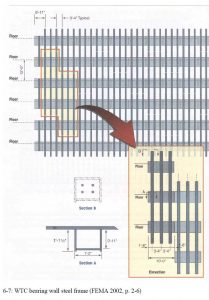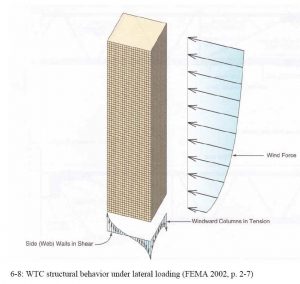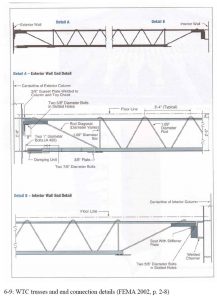The collapse of the twin World Trade Center (WTC) towers on September 11, 2001, provides some insight into the vulnerabilities of steel structures against such attacks. After the event, the Federal Emergency Management Agency (FEMA) conducted an investigation (2002).
The FEMA BPS team made some general observations, findings, and recommendations based on the study of WTC-1 and WTC-2, as well as the other nearby structures:
- ” Structural framing systems need redundancy and/or robustness so that alternative paths or additional capacity are available for transmitting loads when building damage occurs.
- ” Fireproofing needs to adhere under impact and fire conditions that deform steel members so that the coatings remain on the steel and provide the intended protection.
- ” Connection performance under impact loads and during fire loads needs to be analytically understood and quantified for improved design capabilities and performance as critical components in structural frames.
- ” Fire protection ratings that include the use of sprinklers in buildings require a reliable and redundant water supply. If the water supply is interrupted the assumed fire protection is greatly reduced.
- ” Egress systems currently in use should be evaluated for redundancy and robustness in providing egress when building damage occurs, including the issues of transfer floors, stair spacing and locations, and stairwell enclosure impact resistance.
- ” Fire protection ratings and safety factors for structural transfer systems should be evaluated for their adequacy relative to the role of transfer systems in building stability (FEMA 2002, pp. 8-1-8-2).
The Federal Emergency Management Agency published World Trade Center Building Performance Study: Data Collection, Preliminary Observations, and Recommendations, FEMA report No. 403 (FEMA 2002). This report is available online in PDF format at http://www.fema.gov/rebuild/mat/wtcstudy.shtm. In addition to providing a thorough discussion of WTC-1 and WTC-2, the report also discusses the performance of the other nearby buildings, such as WTC-7. Free printed copies of FEMA reports may be obtained directly from FEMA at www.fema.gov.
Illustrations from Chapter 6 of the book Beyond Failure: Forensic Case Studies for Civil Engineers, Delatte, Norbert J., ASCE Press.









